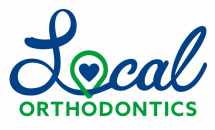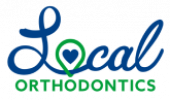Are you dreading flossing with your new braces? All those brackets, rubber bands, and your archwire can be frustrating to maneuver around. But don’t lose hope! If you want to achieve your dream smile, it’s important to commit to a good oral hygiene routine!
Now you may have heard of a waterpik water flosser being the best way to floss with braces, but exactly how do water flossers work and are they effective? Let’s compare the two best methods to cleaning between your teeth – waterpik vs flossing!
Is a waterpik better than flossing?
Now no one flossing method is better than the other. Both waterpik water flossers and traditional flossing are extremely effective ways of removing plaque and leftover food particles from between your teeth and beneath your gums. Just like you chose the best type of braces for you, it’s now time to find the best flossing method for you! So let’s go over how each method will work and their pros and cons to each!
Using a Waterpik Water Flosser with Braces
Waterpik® is an ADA-accepted brand of oral irrigators or water flossers. It’s easily the most popular tool to use when flossing with braces! Waterpiks use a stream of pulsating water to remove food particles and plaque from your teeth and gums.
How do (waterpik) water flossers work? Let’s go over the steps on using a Waterpik water flosser:
- Fill reservoir with warm water then return reservoir to base.
- Select a flosser tip and click into the handle (For first use, set the pressure control dial to high. Point the tip into the sink and turn on until water flows. Turn unit off.)
- Beginning with the lowest pressure setting, lean over the sink and place flosser in your mouth.
- Turn your water-flosser on.
*You can close your lips slightly to prevent splashing (letting water flow from your mouth into sink)*
- Gently guide the flosser tip along your gum line to the space between your teeth.
- Be sure to use your Waterpik on both sides of your teeth—front and back!
- When finished, turn your water-flosser off and use the tip eject button to remove the tip.
- Make sure to drain the reservoir after every use.
Now that you have a better picture of how water flossers work, let’s check out the advantages and disadvantages of waterpik water flossers.
Pros
- Gentle on gums. Water is more soothing than dental floss – especially on sensitive gums!
- Easy to use. There’s no need to worry about maneuvering floss through or around your brackets and archwire!
- Effectively removes plaque. Studies have shown that waterpik water flossers remove 29% more plaque than dental floss.
- Reduces gingivitis and gum bleeding.
Cons
- Messy. With water flossers, water can easily get all over your sink, floor, or face.
- Can be expensive.
- May not remove all plaque from teeth.
- Requires cleaning after every use.
Using Traditional Floss with Braces
Traditional string dental floss is still king of the dental hygiene world. But it can be incredibly frustrating to thread your floss through your braces archwire between each bracket. That’s where an orthodontic floss threader comes in handy! These thin loops of plastic make it easy to guide your floss around orthodontic devices to get all those difficult to reach areas. After your braces are placed, Dr. Jewett can recommend appropriate floss threaders for you.
Here’s how to floss using a threader:
- Cut about 18 inches of waxed floss and thread it into the loop portion of your threader
- Tie floss around the threader loop
- Using the pointed end of the needle, gently guide the threader under your archwire and wrap the ends of the floss around your pointer finger.
- Form the letter ‘C’ with your floss, hugging to the side of one tooth.
- Gently move floss back and forth, slowly rising up to tuck under the curve of your gum and back down.
- Repeat on the next tooth, taking care not to use the same section of floss
- Gently pull floss from wire your archwire to move onto the next section of your braces
- Continue until the sides of all your teeth have been cleaned!
So how does traditional floss measure up against a water flosser? Let’s check out the pros and cons of flossing with dental string.
Pros
- Extremely effective at plaque removal. Dental floss lifts the bacterial film off your teeth instead of rinsing it with water.
- Cost-effective. Buying more than 130 yards of dental floss is under $10 (that’s 260 flossing sessions) while a Waterpik water flosser ranges from $50 -$140.
- Travels well.
Cons
- More abrasive on gums. Gums are more prone to bleeding.
- Harder to use than a Waterpik water flosser
- Awkward to maneuver.
Why is flossing important?
Flossing is absolutely essential—with or without braces. No matter the type of orthodontic treatment you choose (Invisalign®, InBrace®, or braces) or if you don’t undergo treatment at all, you still need to make flossing a part of your daily oral hygiene routine.
As the ADA (American Dental Association) says, “Cleaning between teeth removes plaque that can lead to cavities or gum disease from the areas where a toothbrush can’t reach.”
Your toothbrush brushes the surfaces of your teeth, but think of all the spaces between your teeth, where food particles get stuck and bacteria starts to build up over time.
Not flossing with braces will leave food particles stuck between your teeth and under your gums leading to plaque build-up, gum disease, and cavities.
Protect Your Smile-in-Progress with the Best Flossing Method for You!
Flossing with braces may seem like a lot of work at first – no matter which method you choose! But as you continue to floss every day, you’ll become a pro in no time. Taking care of your teeth is how you experience the best possible results from your orthodontic treatment. When you take care of your teeth, they take care of you! Your diligence in keeping your teeth clean will reward you with a healthy, beautiful smile.
Please don’t hesitate to reach out to us with any questions. Dr. Jewett and our team are here to guide you through your treatment process, from your very first visit to your last appointment.
If you’re looking for a top orthodontist in Johnson City, we’d love to meet you! Request a complimentary exam for you or your child today.








